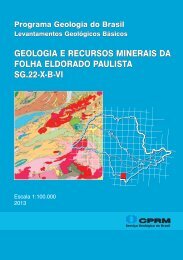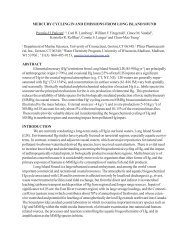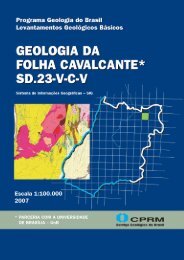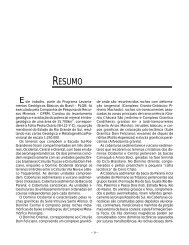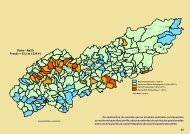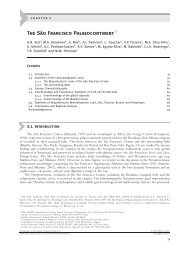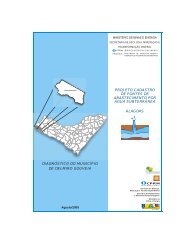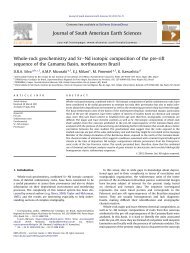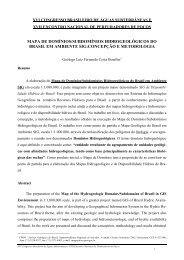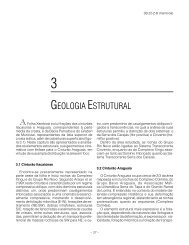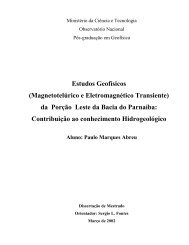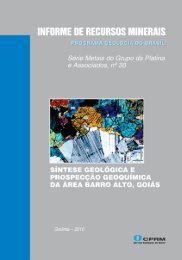Origin of the CO2-only fluid inclusions in the ... - CPRM
Origin of the CO2-only fluid inclusions in the ... - CPRM
Origin of the CO2-only fluid inclusions in the ... - CPRM
You also want an ePaper? Increase the reach of your titles
YUMPU automatically turns print PDFs into web optimized ePapers that Google loves.
extremely rare and negligible. Networks <strong>of</strong> micr<strong>of</strong>ractures filled with<br />
quartz and/or muscovite and tourmal<strong>in</strong>e crosscut both <strong>the</strong> quartz ve<strong>in</strong><br />
and <strong>the</strong> wall-rock and are <strong>the</strong> sites <strong>of</strong> gold deposition. Small quartz<br />
ve<strong>in</strong>lets (b1 cm) cut <strong>the</strong> tourmal<strong>in</strong>e-rich zone and are called here late<br />
barren quartz ve<strong>in</strong>lets.<br />
4.3. Tim<strong>in</strong>g <strong>of</strong> gold m<strong>in</strong>eralisation<br />
Geological <strong>in</strong>formation described <strong>in</strong> <strong>the</strong> previous section <strong>in</strong>dicates that<br />
gold m<strong>in</strong>eralisation <strong>in</strong> <strong>the</strong> Ipit<strong>in</strong>ga Auriferous District is post-metamorphic<br />
and closely related to <strong>the</strong> development <strong>of</strong> <strong>the</strong> host strike–slip shear zones<br />
(Kle<strong>in</strong> and Rosa-Costa, 2003; Kle<strong>in</strong> et al., <strong>in</strong> press). Dat<strong>in</strong>g <strong>of</strong> hydro<strong>the</strong>rmal<br />
muscovite from Carará and <strong>the</strong> nearby and similar Catar<strong>in</strong>o occurrence,<br />
us<strong>in</strong>g <strong>the</strong> 40 Ar– 39 Ar method, yielded ages <strong>of</strong> 1940±20 Ma and 1930±<br />
20 Ma, respectively (Kle<strong>in</strong>etal.,<strong>in</strong>press). These ages are similar to biotite<br />
ages <strong>of</strong> 1928±9 Ma and 1833±13 Ma reported by Rosa-Costa et al.<br />
(2009), which have been <strong>in</strong>terpreted as reflect<strong>in</strong>g post-crystallization<br />
isotopic resett<strong>in</strong>g <strong>in</strong>duced by a widespread <strong>the</strong>rmal event associated with<br />
<strong>the</strong> emplacement <strong>of</strong> anorogenic granitoids elsewhere <strong>in</strong> <strong>the</strong> Amazonian<br />
Craton at 1.88 to 1.86 Ga, and <strong>the</strong> emplacement <strong>of</strong> <strong>the</strong> Waiãpi Granite at<br />
1.75 Ga <strong>in</strong> <strong>the</strong> south-eastern Guyana Shield. Accord<strong>in</strong>gly, <strong>the</strong> 40 Ar– 39 Ar<br />
isotopes constra<strong>in</strong> <strong>only</strong> m<strong>in</strong>imum ages for gold m<strong>in</strong>eralisation at Carará<br />
and elsewhere <strong>in</strong> <strong>the</strong> Ipit<strong>in</strong>ga Auriferous District, which is <strong>the</strong>n bracketed<br />
between 2030 and 1940 Ma. Given <strong>the</strong> synchronicity between ve<strong>in</strong><strong>in</strong>g<br />
and deformation at Carará, m<strong>in</strong>eralisation <strong>in</strong> this deposit likely occurred at<br />
about 2030 Ma.<br />
4.4. Summary <strong>of</strong> published stable isotope data<br />
Kle<strong>in</strong> et al. (<strong>in</strong> press) conducted a reconnaissance stable isotope study<br />
<strong>in</strong> ve<strong>in</strong> materials from <strong>the</strong> Carará deposit, <strong>in</strong> order to trace possible sources<br />
for <strong>the</strong> ore-bear<strong>in</strong>g <strong>fluid</strong>. At a temperature <strong>of</strong> 346 °C, and us<strong>in</strong>g <strong>the</strong><br />
fractionation factors <strong>of</strong> Kotzer et al. (1993) and Chacko et al. (1996), <strong>the</strong><br />
δ 18 OH2O values calculated from quartz range from +6.4 to +7.0‰ <strong>in</strong> <strong>the</strong><br />
E.L. Kle<strong>in</strong>, K. Fuzikawa / Ore Geology Reviews 37 (2010) 31–40<br />
Fig. 3. Photomicrographs <strong>of</strong> <strong>the</strong> host rock at Carará. (A) Foliated quartzite composed <strong>of</strong> quartz (qz), muscovite (mus) and tourmal<strong>in</strong>e (trm); (B) Deformed pyrite crystals (white)<br />
placed with<strong>in</strong> <strong>the</strong> foliation <strong>of</strong> a muscovite-bear<strong>in</strong>g (dark-grey) quartzite.<br />
m<strong>in</strong>eralised ve<strong>in</strong>s, and from +5.2 to +5.6‰ <strong>in</strong> <strong>the</strong> late barren quartz<br />
ve<strong>in</strong>let. Values calculated from tourmal<strong>in</strong>e and muscovite lie <strong>in</strong> <strong>the</strong> range<br />
between +7.0 and +8.3‰. TheδDH2O values <strong>of</strong> <strong>in</strong>clusion <strong>fluid</strong>s are −<br />
33‰ <strong>in</strong> <strong>the</strong> low-grade quartz and −61‰ <strong>in</strong><strong>the</strong>latebarrenquartz<br />
ve<strong>in</strong>lets; values calculated from hydrous silicates vary between −20<br />
and −34‰. The oxygen isotope values for <strong>the</strong> <strong>fluid</strong> lie with<strong>in</strong> <strong>the</strong> range for<br />
both metamorphic and magmatic sources. However, comb<strong>in</strong>ed oxygen<br />
and hydrogen values consistently <strong>in</strong>dicate a metamorphic source for <strong>the</strong><br />
water <strong>in</strong> <strong>the</strong> m<strong>in</strong>eralised ve<strong>in</strong>s at Carará. The <strong>fluid</strong> composition for <strong>the</strong> late<br />
barren quartz ve<strong>in</strong>lets, which is clearly dist<strong>in</strong>ct from that <strong>of</strong> m<strong>in</strong>eralised<br />
quartz, probably reflects a magmatic source.<br />
The measured δ 13 C values <strong>of</strong> carbon CO 2 <strong>in</strong> <strong>fluid</strong> <strong><strong>in</strong>clusions</strong> are −3.4‰,<br />
−3.2‰,and−14.6‰ <strong>in</strong> <strong>the</strong> high-grade, low-grade, and late barren quartz<br />
ve<strong>in</strong>s, respectively (Kle<strong>in</strong>etal.,<strong>in</strong>press).<br />
5. Sampl<strong>in</strong>g and analytical procedures<br />
Samples have been collected on surface m<strong>in</strong>ed exposures <strong>of</strong> <strong>the</strong><br />
deposit. Studies were undertaken <strong>in</strong> different portions <strong>of</strong> <strong>the</strong> ve<strong>in</strong>-quartz<br />
(Fig. 4), here referred to as high-grade quartz, low-grade quartz, and late<br />
barren quartz ve<strong>in</strong>let. Petrographic, micro<strong>the</strong>rmometric and Raman<br />
spectroscopic studies were conducted on <strong>fluid</strong> <strong><strong>in</strong>clusions</strong> hosted <strong>in</strong><br />
quartz crystals <strong>of</strong> <strong>the</strong> three ve<strong>in</strong>/zones. Doubly-polished thick sections<br />
were exam<strong>in</strong>ed under <strong>the</strong> petrographic microscope prior to <strong>the</strong> heat<strong>in</strong>g<br />
and freez<strong>in</strong>g experiments to record <strong>the</strong> distribution, size, types, and<br />
textural relationships <strong>of</strong> <strong>the</strong> <strong>fluid</strong> <strong><strong>in</strong>clusions</strong>. The micro<strong>the</strong>rmometric<br />
study was carried out at <strong>the</strong> Universidade Federal do Pará (Belém, Brazil)<br />
us<strong>in</strong>g a Chaixmeca heat<strong>in</strong>g–freez<strong>in</strong>g stage and follow<strong>in</strong>g procedures<br />
described elsewhere (Roedder, 1984; Shepherd et al., 1985; Wilk<strong>in</strong>son,<br />
2001). The equipment was previously calibrated with syn<strong>the</strong>tic samples<br />
<strong>of</strong> <strong>fluid</strong> <strong><strong>in</strong>clusions</strong>. The data are reproducible to ±0.5 °C for <strong>the</strong> freez<strong>in</strong>g<br />
runs down to −180 °C and ±5 °C for <strong>the</strong> heat<strong>in</strong>g runs up to <strong>the</strong> appropriate<br />
temperature <strong>of</strong> total homogenisation. About 250 <strong>fluid</strong><br />
<strong><strong>in</strong>clusions</strong> have been <strong>in</strong>vestigated by micro<strong>the</strong>rmometry <strong>in</strong> this study.<br />
Fig. 4. Photographs <strong>of</strong> <strong>the</strong> (A) high-grade quartz ve<strong>in</strong> with high concentration <strong>of</strong> tourmal<strong>in</strong>e (white arrow) <strong>in</strong> <strong>the</strong> contact with <strong>the</strong> host rock (<strong>the</strong> pen is 14 cm long), and (B) lowgrade<br />
quartz ve<strong>in</strong>. In both cases <strong>the</strong> host rock is a quartzite.<br />
35



